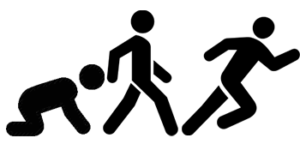
S
o, I’m a fan of scenario-based learning and gamification. Why? Scenario-based learning tends to make materials relevant to learners and doesn’t inherently require that you know your demographic as long as you keep the scenario relevant to the theme of the course. Gamification, on the other hand, isn’t about “entertainment” specifically (or “edutainment”), but about using game mechanics to support learning through extrinsic motivation and curiosity, and by supporting the framework of the narrative. It is about simulation of the reality of your scenario in terms that can be useful for modelling activity, assessing the performance of the learner, and offering a non-linear means of creating a unique learning pathway.
I talk about this a lot. A lot.
I’ve spent a great deal of time studying different types of game mechanics and games—simulations, narrativist, gamist—and the theories behind them. I’ve seen how different modalities and approaches can influence individual progress through an experience. Furthermore, the choices made by the individual are deeper reflections of preference and personality.
The impact of games and, just as importantly, stories can be profound. They offer a gateway to the learning experience by connecting to deeper levels of curiosity and exploration.
The Archaeological Method
The Montpelier Archaeology Department hit upon the “L.E.A.R.N.” acronym as part of their thematic “Montpelier Expeditions” where paying members of the public become “citizen-scientists” and join the archaeological team for a week-long experience. While the development of these programs was organic, they serendipitously ended up echoing the archaeological research process as experienced at James Madison’s Montpelier:
LOCATE
Identify the location of a cultural site using traditional archaeological or remote survey
ANALYZE
How do archaeologists analayze the recovered data (e.g., artifacts) and use them to reconstruct a site
EXCAVATE
Using traditional and modern archaeological methods, document, excavate, and recover cultural materials.
RECONSTRUCT
How do you start conversations about the past using archaeological data?
The L.E.A.R.N. Online syllabus was designed around these separate themes as part of a hierarchical online learning experience where learners would only get as much detail as they wanted. In many ways, this echoed the old joke about museum patrons’ preference for negotiating around the exhibit (“Sprinters, Walkers, Crawlers”):
- Level 0 Learners: Our ‘sprinters’ that wanted a thumbnail image of what the experience would entail and the type of activities they would be engaging in.
- Level 1 Learners: The ‘walkers,” who wanted a little bit more information than just a thumbnail and might want to learn more about specific activities.
- Level 2 Learners: The ‘crawlers’ that would want to explore all the activities, perhaps across multiple program types, and would keep on coming back for me.
- Level 3 Learners: The Questing Beast, perhaps, but this would be an individual that had more than a passing interest in archaeology in general—students, either general education or degree-track, might be examples of this level of learner.
SPRINTERS: A sprinter will move rapidly through the exhibit, reading an occasional bit of text or looking at an object, image, or video.
WALKERS: Not of The Walking Dead variety, but rather individuals that immerse themselves to a greater extent in the exhibit but still don’t engage with 100% of the materials.
CRAWLERS: This museum patron reads every single bit of text, looks and studies at every piece of media, perhaps multiple times, and me even go through exhibits more than once.

Back to Basics—Learning Objectives
To really tackle what the learning game will be about two things have to be done.
- Decide what is going to be the subject, which in this case is easy: the first one, Locate.
- Remember the learning objectives: if the game isn’t covering at least one of the learning objectives, it is going to be a dissonant and frustrating learning experience.
So, what are the Locate learning objectives?
- SURVEY. Identify, (1) the primary means by which archaeologists identify the location of cultural sites, and (2) the means by which systematic survey is achieved;
- IDENTIFY. Recognize the characteristics of ubiquitous metal and non-metal artefacts in the archaeological record;
- CHRONOLOGY. Identify the primary means by which archaeologists can date a site in historical contexts: stratigraphy, and artefact dating; and
- CONSERVE: Discuss the primary conservation technique for iron artefacts and demonstrate awareness of the differences between non-iron conservation types.
Of these LOs, the first three—Survey, Identify, and Chronology—lend themselves most readily to a single, scenario-based learning game. While conservation is a primary concern once artefacts have been removed from the ground, in the context of the L.E.A.R.N. Online syllabus, in this expedition it was included as something of primary interest to the avocational metal detectorists.
The Basic Premise of the Game
The successive approximation model (SAM) for design often requires the instructional designer (ID) to come up with ideas for a curriculum, learning objectives, methods that these will be achieved and measured, etc. Then, in the so-called “savvy start,” they work with subject matter experts (SMEs) and other stakeholders to begin to dial into the specifics of the course. Thereafter it’s up to small, successive and iterative design improvements. Start small, fail small.
Luckily, in this case, I happen to be both the ID and SME. Call me, errr, Smeid (shades of Lord of the Ring)…
So, the gist. For the first LO, we basically need to illustrate the advantages and disadvantages of systematic survey, or the avocational metal detectorists following their ‘gut’ and ‘eye’ (read: experience with the lay of the land) and the archaeologist using grid-based survey methods. As what we are trying to illustrate here is the use of the metal detector as a rapid remote sensing device, assigning a budget to a survey program, having a grid that the learner has to apply different methods to, and getting data from those selections seems like an obvious move forward. It gives multiple insights from both survey and data recovery strategies, as well as putting that positive spin on avocational metal detectorists (there is a long and troubled history between the two groups).
This process will reveal to the learner a series of data from the different survey types employed within their budget. This gets us to the second LO, where the learner will have to identify what artefacts are and what their time period is (luckily, the third LO).
And with that...
This post is long enough. I retroactively call this Post I in a series dedicated to designing the Locate learning game. In Part II, we’ll explore in more detail the variables and game mechanics that will be required, as well as begin to storyboard out both of those.







